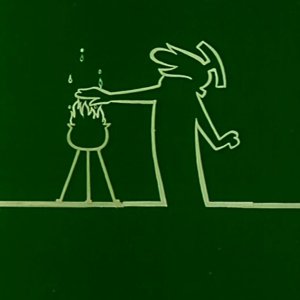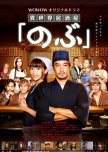Making the world a better place by lovingly preparing one dish at a time.
There's not much plot, apart from the last two episodes. But that doesn't matter, it's just about people cooking, serving and eating different, mostly Japanese dishes.
Really, if you're waiting for an explanation for why there's a connection between the worlds, or how the owner can buy things in our world with currency from the other world, you'll be disappointed.
The whole thing is a thinly disguised food appreciation show, with some loveable characters who do the appreciation.
I was reminded of Wakako Zake.
Bonus points for the German, the texts that were readable had actually decent German. (If I wanted to nitpick, I'd mention that the Fraktur font needs a "long s" at the beginning and in the middle of a syllable instead of the "round s" (only used at the end of a syllable), but I won't.)
The isekai the tavern connects to has elements of different centuries -- for example: references to a northern God whose name sounds a lot like "Oden" (early middle ages, maybe around 6th cent.) or the buildings in the town (late middle ages to early renaissance, so ca. 14th to 16th cent.) or the clothing (somewhere in the 17th and 18th cent.) or the mention of Kartoffeln as main staple of food (late 18th and 19th cent.) and the Fraktur font (mainly late 19th and early 20th cent.) -- so it's not medieval, but firmly in the realm of fantasy.
If you just want to see how some Japanese-style food can make a society a bit better, and want to relax watching people enjoy this food while bickering a bit, then this might be for you.
Really, if you're waiting for an explanation for why there's a connection between the worlds, or how the owner can buy things in our world with currency from the other world, you'll be disappointed.
The whole thing is a thinly disguised food appreciation show, with some loveable characters who do the appreciation.
I was reminded of Wakako Zake.
Bonus points for the German, the texts that were readable had actually decent German. (If I wanted to nitpick, I'd mention that the Fraktur font needs a "long s" at the beginning and in the middle of a syllable instead of the "round s" (only used at the end of a syllable), but I won't.)
The isekai the tavern connects to has elements of different centuries -- for example: references to a northern God whose name sounds a lot like "Oden" (early middle ages, maybe around 6th cent.) or the buildings in the town (late middle ages to early renaissance, so ca. 14th to 16th cent.) or the clothing (somewhere in the 17th and 18th cent.) or the mention of Kartoffeln as main staple of food (late 18th and 19th cent.) and the Fraktur font (mainly late 19th and early 20th cent.) -- so it's not medieval, but firmly in the realm of fantasy.
If you just want to see how some Japanese-style food can make a society a bit better, and want to relax watching people enjoy this food while bickering a bit, then this might be for you.
Considerați utilă această recenzie?


 2
2











